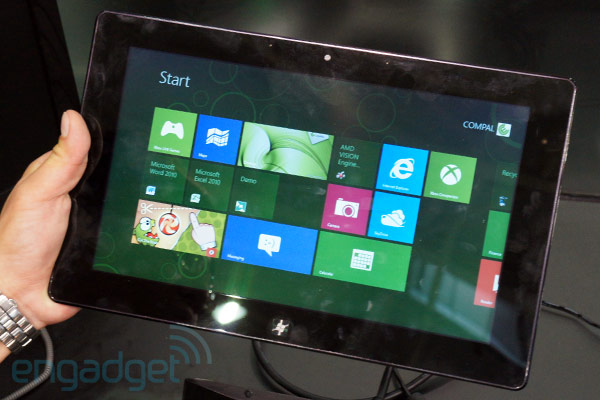Right now many companies that are building tablets for Microsoft’s next generation OS are using either Intel’s Atom CPUs, ULV versions of Sandy Bridge (or even Ivy Bridge in some rare cases), or they have opted for one of the ARM based SoCs that are available (with nVidia’s Tegra 3 being a popular choice). Despite AMD’s bold push into the ultra-low voltage market they have not found their way into that many tablet designs (we only know of 2-3 that are anticipating using AMD right now).
AMD really has to act now and get the word out about the benefits of their APUs in these devices. When you think about the requirements for an x86/64 tablet that is able to access all of the features of Windows 8 AMD’s APUs actually make sense. They have great graphical performance (as we have said more than once) and can push this without a major hit to batter life (as we have seen with some of the Lenovo laptops featuring Llano). So what AMD needs (and what they appear to be showing) is a tablet that can push 1366x768 (the minimum resolution for the Windows 8 snap feature) with a screen size larger than 10-inches (again something we predicted would be the norm) and good battery life.
AMD’s prototype showing was built by Compal according to all of the images we have seen (we are waiting on more details from AMD) and features a Trinity A6 APU, although which model we do not know yet. The new tablet also features the now common keyboard dock/extra battery. This feature was made popular with Asus’ Transformer series and despite what Tim Cook might say, is a feature that we have heard many potential buyer say they would love to have (even some iPad owners).
We will try and see what additional information we can get from AMD (including any design wins they might have) but with early prototypes like this we probably will not be able to get much from them. Again, and we cannot stress this enough, for AMD’s APU push to work as intended AMD needs to get their APUs inside Tablets and Thin and Light notebooks (Ultrabook is an Intel word AMD calls theirs Slimbooks). We will be interested to see what happens between now and the Windows 8 launch day as well as how many products shipping with Windows 8 feature AMD APUs inside; considering the number of anticipated products (the estimated count is now well over 20 on launch day) AMD had better hope for a slice of that pie or they might miss out on some of the coveted market share.
Picture Credit Engadget
Discuss this in our Forum

 At Computex in Taipei AMD is showing off a prototype Windows 8 tablet. This is something that we predicted they would do right after they announced their shift to low power CPUs (well really APUs). It was a move that we predicted was not only logical, but one that was necessary for AMD with the shift to tablets and ultrabooks that many companies are making in anticipation of Windows 8 and its very touch oriented design.
At Computex in Taipei AMD is showing off a prototype Windows 8 tablet. This is something that we predicted they would do right after they announced their shift to low power CPUs (well really APUs). It was a move that we predicted was not only logical, but one that was necessary for AMD with the shift to tablets and ultrabooks that many companies are making in anticipation of Windows 8 and its very touch oriented design.

